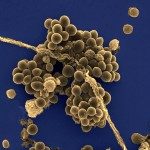Link to Pubmed [PMID] – 14762013
J. Bacteriol. 2004 Feb;186(4):1175-81
The YycG/YycF essential two-component system (TCS), originally identified in Bacillus subtilis, is very highly conserved and appears to be specific to low-G+C gram-positive bacteria, including several pathogens such as Staphylococcus aureus. By studying growth of S. aureus cells where the yyc operon is controlled by an isopropyl-beta-D-thiogalactopyranoside (IPTG)-inducible promoter, we have shown that this system is essential in S. aureus during growth at 37 degrees C and that starvation for the YycG/YycF regulatory system leads to cell death. During a previous study of the YycG/YycF TCS of B. subtilis, we defined a potential YycF consensus recognition sequence, consisting of two hexanucleotide direct repeats, separated by five nucleotides [5′-TGT(A/T)A(A/T/C)-N(5)-TGT(A/T)A(A/T/C)-3′]. A detailed DNA motif analysis of the S. aureus genome indicates that there are potentially 12 genes preceded by this sequence, 5 of which are involved in virulence. An in vitro approach was undertaken to determine which of these genes are controlled by YycF. The YycG and YycF proteins of S. aureus were overproduced in Escherichia coli and purified. Autophosphorylation of the YycG kinase and phosphotransfer to YycF were shown in vitro. Gel mobility shift and DNase I footprinting assays were used to show direct binding in vitro of purified YycF to the promoter region of the ssaA gene, encoding a major antigen and previously suggested to be controlled by YycF. YycF was also shown to bind specifically to the promoter regions of two genes, encoding the IsaA antigen and the LytM peptidoglycan hydrolase, in agreement with the proposed role of this system in controlling virulence and cell wall metabolism.

